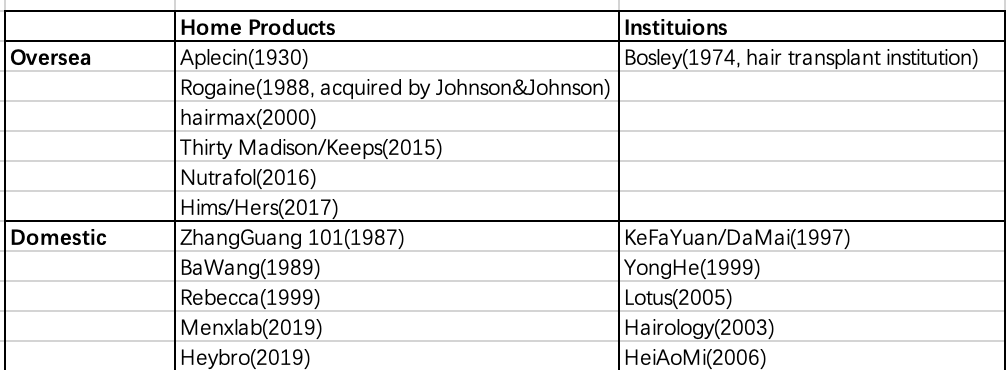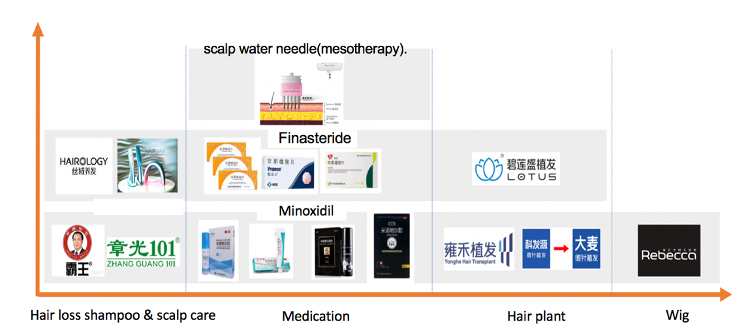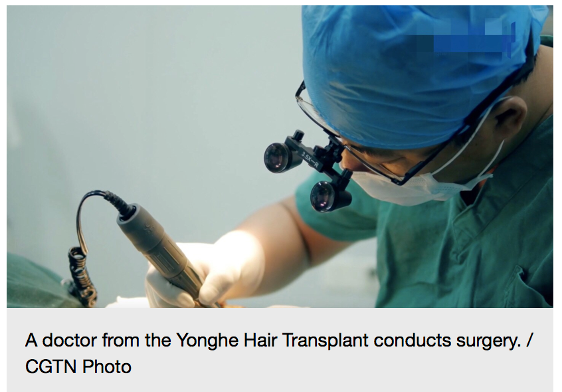Ventech China Insights | Finding Hims in China - Hair Care Industry In China
1. What 250 million young Chinese are facing: Easy to be bald and hard to be in relationship.
Today, “hair loss” has become a buzzword and major concern among young Chinese. A report released earlier by the China Association of Health Promotion and Education estimated that 250 million Chinese are plagued by hair loss, mainly those aged between 20 and 40.
Since it’s about the same total number of people of who are not in a relationship and those who are losing hair, there is a joke about that to be bald is relatively easy while to be in relationship is much harder for young generations in China.
According to a top hair transplant institution, the consumers of hair transplant are becoming younger on whole, in which 70% are male and 30% are female. Reasons for hair loss can be many, from genetic to environmental. Increasing work pressure, staying up late and erratic hours are causing the hairline of young generations to recede. From 2017 to 2018, those suffering from hair loss aged between 26 and 30 took up 41.9 percent, becoming the largest among all age groups. Those who work in IT industry and management positions are usually high risky population of hair loss.
With the popularity of Hims in the U.S since 2017, many Chinese startups are entering into the area of hair loss prevention. The domestic market size of personal hair care is expected to reach hundreds of billions of RMB in next 5 years.

2. Global Hair Care Products/ Services:
The growth in the hair care market is a global phenomenon.
Companies include but not limited to:

3. A Glimpse of the Hair Care Market In China:
The market size of China hair care product is about 1.5 billion RMB.
Currently, high-end local hair care brands are hot sellers. Products priced between RMB 50 to 100 are the most favored by consumers.
Leading hair shampoo brands by E-commerce sales revenue include BaWang, Ryo, The Body Shop , ZhangGuang 101, Yanagiya, Zooly, Head&Shoulders, Seeyoung, Kerastase, Shiseido, etc.
However, since consumers are getting younger and younger, traditional sales channel and products such as Bawang becomes less effective in terms of reaching and convincing customers. The most direct solution to hair loss is medication treatment as soon as the problem is been observed, shampoo can’t stop hair from falling off but only clean scalp and lubricate hair.

The market penetration of pharmaceutical products that have actual effect on preventing hair loss still has space to grow.
According to the report released by the trichology group of the Society of Dermatology and Venerology of Chinese Medical Association, people who suffers from mild to moderate level hair loss should be treated with medications prior to hair plant surgery, because hair plant is more suitable for those who have no positive response to drug treatment. Since the success to hair transplant surgery mostly depend on whether the patient has enough healthy follicles to be transplanted, the surgery can only be performed after the consumer’s hair loss is under control (the average survival rate of transplanted hair follicles is around 85%).
Up to now, there are only two anti-hair loss drugs approved by FDA and the U.S and China: Minoxidil and Finasteride.
What’s interesting is that, Finasteride is included into the National Reimbursement Drug List in both China and US, the product specification of 5mg is used for prostatic diseases, while 1mg is used to treat hair loss, the price of 1mg Finasteride is generally 7-8 times higher than that of 5mg in China.
In the U.S, Hims has built up a one-stop subscription channel of drugs like Finasteride, through which the customers can easily subscribe Finasteride from the website of Hims and only need to pay part of the fee. In China, any marketing or advertisement of Finasteride through public media channels is restricted so far, hospitals and pharmacies are the major distribution channels. Put aside brand differences and patent costs in early stage, the undeveloped marketing channel leads to higher marketing expense. So that the price of 1mg Finasteride (for hair loss control) is higher than that of 5mg (for prostatic diseases treatment).
Therefore, Finasteride still has large space to grow in terms of the distribution channel penetration in China.
In China, the market of Hair/scalp caring is also huge.
Hairology, the biggest hair/scalp care institution in China, has more than 2,500 chain stores across the country. The service procedure is similar to that of beauty salon and SPA institution, except their self-developed hair cleaning and caring products, Hairology also provides treatment such as scalp water needle(mesotherapy) to customers. Some hair transplant institutions are also expanding their businesses to scalp care service.

Besides all kinds of hair care products, China has seen a boom in hair transplant institutions in recent years as the demand continues to grow. Private owned instituions are the main force in local hair transplant market. The revenue of top 3 private chained hair transplant institutions ( Lotus, Yonghe and KeFaYuan/Barley) ranges from RMB 300 million to 1 billion in 2019.

Key Characteristics of Hair transplant Industry are:
1) High ATV (Average transaction value)and direct change to appearance.
2) The capacity of hair transplant institution is limited as the rate of success is highly depend on the experience of the doctor as well as the quality of patients’ hair follicles. The economic benefit of a hair transplant surgery, therefore, is not higher than a cosmetic surgery at the similar ATV(The time for the hair transplant surgery is between 3-5 hours according to the number of follicles needed to be transplanted).
3) It’s a marketing driven industry: there is barely any repurchase for hair transplant consumption. The marketing expense of the mentioned top 3 hair transplant institutions remains around 30%-35% of the revenue and may continue to grow.
If we refer to the Japan anti-hair loss market whose market has been stable overtime, hair transplant only takes about 5% of the market share, while cleaning, care and medication reaches 60%-70%. Since the surgery only changes where the hair grows instead of preventing original hair from keeping falling off, for those who already accepted hair transplant surgery, unhealthy lifestyles such as staying up late and erratic hours will still lead to hair loss. After care for the hair transplant surgery is very important, in the meantime of keeping healthy lifestyle, using medication to keep the hair loss under control is also necessary. Otherwise, hairpieces or wig may also be good alternative for those who run out of options.
The challenges for Chinese startups?
Different from the U.S, Chinese e-commerce brands rely heavily on the major e-commerce platforms include Tmall, JD, or Douyin for traffic acquisition and transaction. In China, the distribution channels for Minoxidil (OTC) are relatively rich, for example, the monthly sales of Minoxidil on Alibaba and JD is over 20,000 units, while the sale of Finasteride is still restricted by the distribution channel of prescription drugs. When we look at the market in the U.S, the boost of Hims is highly related to the online E- prescription system.
In the U.S, E-prescription has been implemented since 2007 and 80% of all prescriptions are e-prescription in 2019. Only until 2013 did various new online prescription drug companies begin to appear, TruePill, a B2B drug delivery platform, is one of them. Hims cooperates with TruePill in terms of the supply chain and prescription online drug orders. For example, when a customer submit for products include prescription drug Hims, an online consultation with a physician will be arranged to determine if a prescription is appropriate, If yes, Hims will send out the request to the order process center of Truepill for electronic inspection, then TruePill will allocate the medication and attach the brand tag of Hims before delivery.
In general, except drawing on the experience of Hims in terms of providing on-stop solution include medication, hair care products, nutrition and skincare products, in China, to build up a new anti-hair loss brand for young consumers, product positioning, policy, distribution channels and supply chain are all core considerations.

Nevertheless, there are no drugs that can completely cure hair loss.
With all above solutions, it’s still believed that the anti-hair loss market among young consumers will continue to expand in the future, as they care a lot about their appearance, but are unwilling to change their unhealthy lifestyle.
